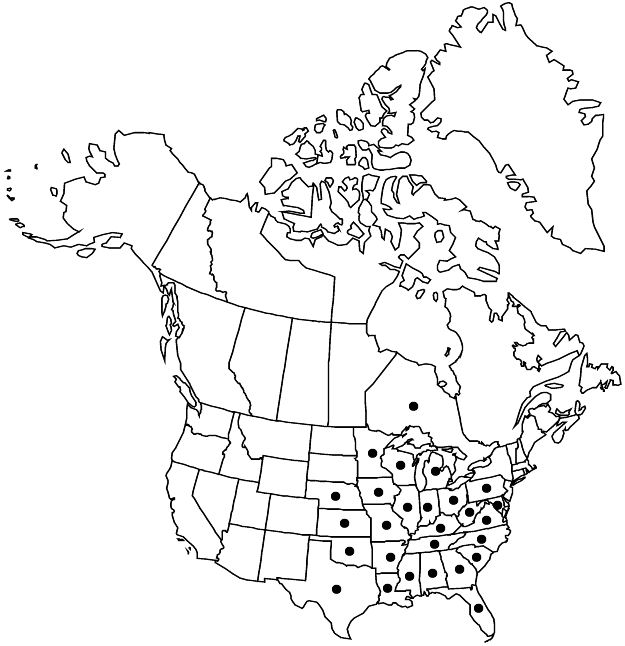Hibiscus laevis
Auct. Syn. Meth. Stirp. Taurin., 31. 1773.
Herbs, perennial, to 2.5 m, herbage glabrous or nearly so throughout. Stems often glaucous. Leaves: stipules caducous, linear-subulate, 2–10 mm; petiole 1/2 to somewhat exceeding blade; blade narrowly to broadly ovate or triangular or lanceolate-ovate, usually hastately 3 (–5) -lobed, sometimes unlobed, 6–18 × 3–16 cm, base cordate to truncate, lobes, especially middle one, ovate to triangular, to 3 times as long as wide, margins crenate-serrate to serrate or serrate-dentate, apex acuminate to long-acuminate, surfaces glabrous, nectary absent. Inflorescences solitary flowers in axils of distal leaves. Pedicels jointed distally, 1–10 cm, 1/3 to slightly exceeding subtending petioles; involucellar bractlets (8 or) 9–15 (or 16), linear-subulate, 1–3 cm, margins not ciliate. Flowers horizontal; calyx divided 1/3–1/2 length, broadly cylindric-campanulate, 2.5–3 cm, conspicuously larger in fruit, lobes broadly triangular, apices acute, surfaces glabrous, nectaries absent; corolla broadly funnelform, petals pink to white, red basally, obovate, 5–8 × 2–5 cm, apical margins entire to repand, finely hairy abaxially where exposed in bud; staminal column straight, pale-pink to white, 2.5–4 cm, ca. 1/2 as long as petals, bearing filaments nearly throughout, free portion of filaments not secund, 2–4 mm; pollen pale-pink to white; styles pale-pink to white, 5–12 mm; stigmas pink. Capsules brown, ovoid, 1.8–3 cm, apex truncate, apiculate, glabrous. Seeds reddish-brown to brown, reniform-globose, 3–5 mm, hairy, hairs reddish. 2n = 38.
Phenology: Flowering Jun–Oct.
Habitat: Edges of freshwater lakes, larger, slow-moving streams, floodplain pools, wet roadside ditches, artificial ponds
Elevation: 0–400 m
Distribution

Ont., Ala., Ark., Fla., Ga., Ill., Ind., Iowa, Kans., Ky., La., Md., Mich., Minn., Miss., Mo., Nebr., N.C., Ohio, Okla., Pa., S.C., Tenn., Tex., Va., W.Va., Wis.
Discussion
B. P. G. Hochreutiner (1900) inexplicably merged Hibiscus laevis with the very different H. coccineus.
Hibiscus laevis has been recorded from Pelee Island in southernmost Ontario, but the 1904 collection is thought to have represented a short-lived population, as the species apparently has not since been found there (R. L. Stuckey 1968b). A report from the Bronx, New York (R. DeCandido 1991), well northeast of its closest previously known occurrence, is likely of an introduction or an escape.
There are reports of recent northward spread of Hibiscus laevis along larger streams (C. C. Deam 1940; M. L. Roberts and R. L. Stuckey 1992; Stuckey 1968b; F. H. Utech 1970). R. B. Kaul (pers. comm.) reported similar upriver increases in Nebraska on the Elkhorn, Missouri, and Platt rivers. Hibiscus laevis sometimes forms natural hybrids with H. moscheutos subsp. moscheutos, usually in man-made habitats (O. J. Blanchard 1976).
Selected References
None.
Lower Taxa
"/3" is not declared as a valid unit of measurement for this property.